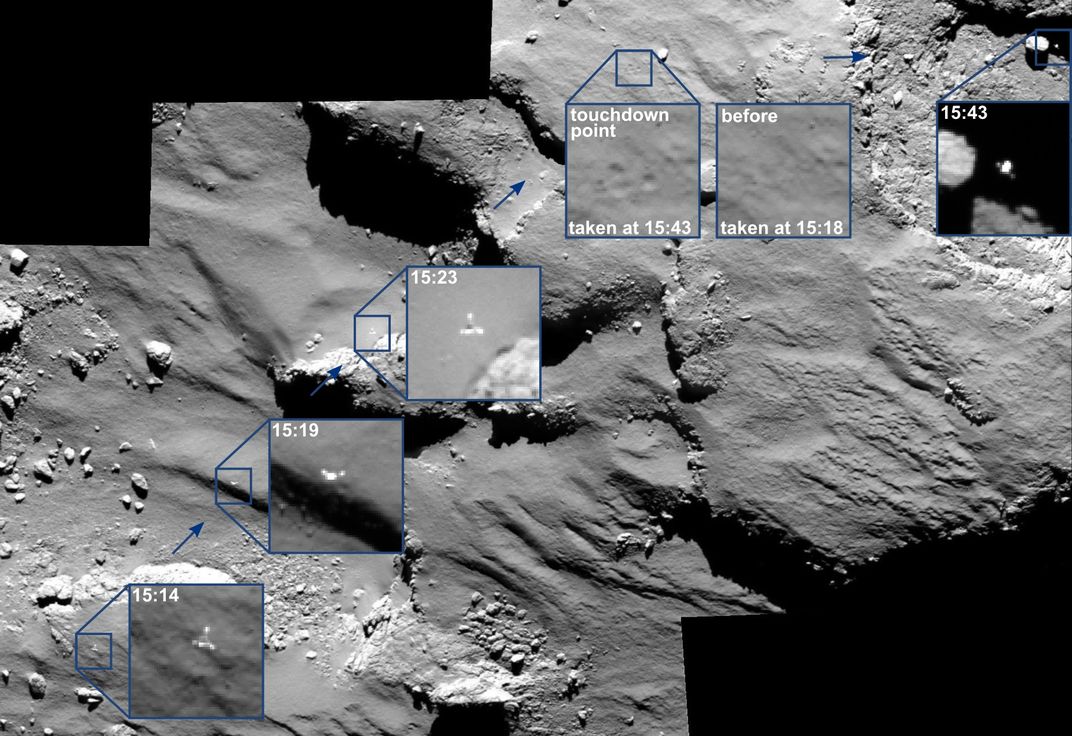Watch the Philae Lander’s Bouncing Touch Down on Comet 67P
A year after its crash-landing, researchers reflect on the unexpected successes of the mission
/https://tf-cmsv2-smithsonianmag-media.s3.amazonaws.com/filer/55/b6/55b6a8d7-09fd-4a42-a83a-4d0db9c2f84e/comet_wide-angle_view.jpg)
In a historic mission just over one year ago, the Rosetta spacecraft's lander Philae touched down on the surface of comet 67P/Curyumov-Gerasimenko. The intrepid spacecraft traveled for 10 years and more than 4 billion miles to reach the comet—but things didn’t go exactly as planned.
The washing-machine-sized lander briefly hit it's target before caroming off the surface and flipping through space before finally returning to the comet. Now, the folks at the European Space Agency, the brains and talent behind the mission, have put together an animation of the little lander bouncing across the comet’s rocky surface. The reconstruction "makes the car stunts in James Bond movies look positively safe," as BBC Earth puts it.
The agency explains in a press release that the animation is based on data collected by both Rosetta and Philae. That’s how the agency knew that the lander tumbled feet over solar cell-covered hood before coming to rest two hours after its first touch down.
The video isn’t just for fun: It helps scientists learn how and why the lander went into it's nerve-wracking bounce. “I am astonished how lucky we were!” says Jens Biele, in a blog post from the ESA. Biele is the lead author of a scientific paper that contributed to this simulation, showing how the surface of the comet affected the landing.
Despite the unplanned bouncing—and the failure of harpoons to fire that would have anchored Philae to the comet—the lander made measurements and sent 80 percent of the data planned for its first science sequence. Then, batteries exhausted, Philae hibernated.
By June the comet had moved close enough to the sun for light to reach the lander’s panels and the ESA team picked up a call from Philae. Yet after only a few more status reports, the sun's heat brought the comet to life beneath Philae, sending streams of gas and dust back to create its tail.
For safety, the Rosetta probe backed away—out of range of the lander's pings.

Now, the comet has swung away from the Sun and begun its journey back into the depths of the solar system. Rosetta has swooped closer and could pick up contact, but that chance seems to be slim.
"We had already determined that one of Philae's two receivers and one of the two transmitters were likely no longer working," says Koen Geurts, Philae's technical manager at DLR's Lander Control Centre in Cologne, Germany, in the press release.
Instead, the team’s focus has shifted to the final phase of the mission. Rosetta will soon start an excursion to fly through the comet’s tail, about 1,240 miles out. Once the comet and it’s robotic companions travel past the orbit of Jupiter, not enough sunlight will reach the solar panels on either device to keep operations up.
The current plan is for Rosetta to circle close to the comet a few times before crash-landing on the surface at the end of next September and joining Philae to rest for ever more.

